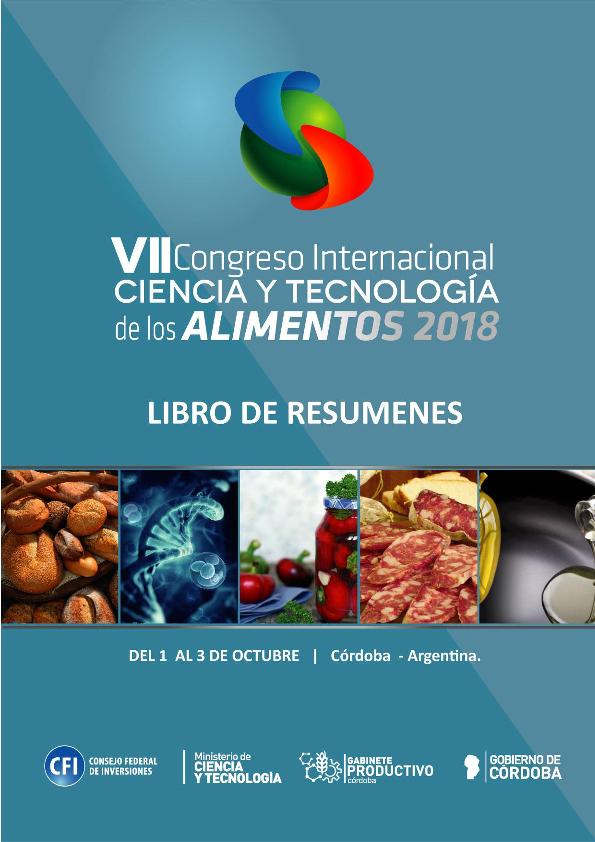Mostrar el registro sencillo del ítem
dc.contributor.author
Rueda, Julio Ricardo

dc.contributor.author
Lobo, Manuel Oscar

dc.contributor.author
Samman, Norma Cristina

dc.date.available
2023-08-09T14:44:33Z
dc.date.issued
2019
dc.identifier.citation
Protein hydrolysis, peptide fractionation and antiradical activity of peptides produced from extruded and non extruded quinoa (Chenopodium quinoa wild) grains; VII Congreso Internacional Ciencia y Tecnología de los Alimentos; Cordoba; Argentina; 2018; 528-529
dc.identifier.isbn
978-987-45380-93
dc.identifier.uri
http://hdl.handle.net/11336/207609
dc.description.abstract
The objective of this work was to evaluate the effect of extrusion of quinoa seeds on the protein hydrolysis and radical scavenging activity of different peptide fractions. Quinoa protein isolates were obtained from defatted flour of extruded and non-extruded grains. Isolates were obtained by alkaline solubilisation and acid precipitation, followed by centrifugation and drying in a flux oven at 30ºC until constant weight. Dried isolates were powdered and protein content was determined. Quinoa protein hydrolysis was performed at 50ºC and pH 9.0 on 10mg/mL protein suspension. Alcalase was added to the suspension in ratio enzyme-substrate 1:10 and pH was corrected to 9.0 with NaOH. Reaction dynamic was monitored over 30 minutes and stopped by thermal inactivation of enzyme (80ºC for 10 min). The hydrolysis degree (HD) was calculated using pH-stat method. Then, the slurry was cooled down to room temperature and centrifuged (10 min, 5000g). Polypeptides and peptides in the supernatant were fractionated by ultrafiltration. Fractions of >10; 10-5; 5-3 and <3 kDa were recovered and analysed. Measurements of soluble protein (Bradford method), total nitrogen content (TNC) (Kjeldahl´s determination), 10% TCA soluble peptides, α-amino groups (TNBS reaction) and radical scavenging activity (using 2,2-diphenyl-1-picrylhydrazylradical) were tested for each fraction. Protein isolates from extruded and non-extruded quinoa seeds showed protein content of 55.35 and 64.93 %, respectively. Over the hydrolysis process, the HD was similar to both slurries and reached 27% after 30 min. At this point, peptide separation of treated and untreated seeds, evidenced a higher content of nitrogen for the <3 kDa fraction (50.0 and 50.54% of TNC). Fraction of 10-5 kDa was the second one having an important content of nitrogen (29.67 %). DPPH radical scavenging activity of peptide fractions from extruded grains showed 20% of antiradical activity (10% more than non-extruded quinoa grains). Fraction of 5-3 kDa was the poorest in content of soluble protein, TNC, α-amino groups and low radical activity. Evidently, extrusion had a notable effect on the production of peptides of <3 kDa. Although it was not evidenced in the total HD after 30 min, the type of peptides seemed different since DPPH assay denoted an increase in the antiradical activity for the peptide fraction from extruded grains, also considering the same amount of nitrogen and amino groups to both fractions of treated and un-treated grains. In conclusion, the hydrolysis performed produced a <3 kDa fraction rich in peptides and extrusion improved its antiradical activity.
dc.format
application/pdf
dc.language.iso
eng
dc.publisher
Ministerio de Ciencia y Tecnología de la provincia de Córdoba
dc.rights
info:eu-repo/semantics/openAccess
dc.rights.uri
https://creativecommons.org/licenses/by-nc-sa/2.5/ar/
dc.subject
Quinoa
dc.subject
extrusion
dc.subject
hydrolysis
dc.subject
peptides
dc.subject.classification
Bioprocesamiento Tecnológico, Biocatálisis, Fermentación

dc.subject.classification
Biotecnología Industrial

dc.subject.classification
INGENIERÍAS Y TECNOLOGÍAS

dc.title
Protein hydrolysis, peptide fractionation and antiradical activity of peptides produced from extruded and non extruded quinoa (Chenopodium quinoa wild) grains
dc.type
info:eu-repo/semantics/publishedVersion
dc.type
info:eu-repo/semantics/conferenceObject
dc.type
info:ar-repo/semantics/documento de conferencia
dc.date.updated
2023-02-16T11:17:16Z
dc.journal.pagination
528-529
dc.journal.pais
Argentina

dc.journal.ciudad
Córdoba
dc.description.fil
Fil: Rueda, Julio Ricardo. Universidad Nacional de Jujuy. Centro Interdisciplinario de Investigaciones en Tecnologías y Desarrollo Social para el Noa. - Consejo Nacional de Investigaciones Científicas y Técnicas. Centro Científico Tecnológico Conicet - Salta-Jujuy. Centro Interdisciplinario de Investigaciones en Tecnologías y Desarrollo Social para el Noa; Argentina
dc.description.fil
Fil: Lobo, Manuel Oscar. Universidad Nacional de Jujuy. Centro Interdisciplinario de Investigaciones en Tecnologías y Desarrollo Social para el Noa. - Consejo Nacional de Investigaciones Científicas y Técnicas. Centro Científico Tecnológico Conicet - Salta-Jujuy. Centro Interdisciplinario de Investigaciones en Tecnologías y Desarrollo Social para el Noa; Argentina
dc.description.fil
Fil: Samman, Norma Cristina. Universidad Nacional de Jujuy. Centro Interdisciplinario de Investigaciones en Tecnologías y Desarrollo Social para el Noa. - Consejo Nacional de Investigaciones Científicas y Técnicas. Centro Científico Tecnológico Conicet - Salta-Jujuy. Centro Interdisciplinario de Investigaciones en Tecnologías y Desarrollo Social para el Noa; Argentina
dc.relation.alternativeid
info:eu-repo/semantics/altIdentifier/url/https://cicytac.cba.gov.ar/wp-content/uploads/2018/12/Libro-de-Res%C3%BAmenes-VII-CICYTAC-2018.pdf
dc.conicet.rol
Autor

dc.conicet.rol
Autor

dc.conicet.rol
Autor

dc.coverage
Internacional
dc.type.subtype
Congreso
dc.description.nombreEvento
VII Congreso Internacional Ciencia y Tecnología de los Alimentos
dc.date.evento
2018-10-01
dc.description.ciudadEvento
Cordoba
dc.description.paisEvento
Argentina

dc.type.publicacion
Book
dc.description.institucionOrganizadora
Ministerio de Ciencia y Tecnología de la provincia de Córdoba
dc.source.libro
VII Congreso Internacional Ciencia y Tecnología de los Alimentos 2018 : libro de resúmenes
dc.date.eventoHasta
2018-10-03
dc.type
Congreso
Archivos asociados
